|
A trip to the Four
Corners Don
Campbell |
| Don
Campbell has been on his travels and brings us news of the cacti in the
Four Corners region of the American Southwest. You can click the
thumbnails in this article for a high resolution tour. |
|
Sunday,
May 22
Following
a fairly full and quite successful day of cactus & scenery viewing,
the CCSS group pulled into a shady picnic table in Snow Canyon State Park
near St. George, UT. The mid afternoon record high heat had apparently
sapped nearly everyone’s enthusiasm for any more trekking about and
looking for plants. Nevertheless, I suggested that anyone interested in
searching for Agave utahensis might want to accompany Carol &
me on a “wild goose chase” into an area where I’d seen a plant
several years earlier. No one in the group accepted my offer, preferring
instead to continue visiting in the relative coolness of a shady tree.
Carol
& I drove to the Petrified Dunes Trailhead and began wandering amongst
the colourfully sculpted landscape. We saw many showy wildflowers,
including a number of yuccas in full flower. After about half an hour I
spotted a bright yellow “candle” extending up from behind one of the
petrified dunes. I immediately recognized this as the inflorescence of an
elusive A. utahensis.
|
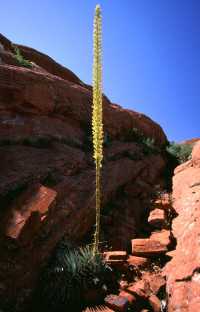
Agave
utahensis in flower at the Snow Canyon State Park near St George, UT. |
While
Carol continued looking in the immediate area of the A. utahensis, I
headed back to the trailhead parking to get my camera gear. (I was using my
long-established technique for finding plants in habitat...Leave the camera
equipment in the car and one is practically guaranteed of finding the plant
which then requires backing and forthing trips to capture the desired photo.)
Part
way back to the trailhead I encountered Reed & Bobbie Irwin and their St.
George friends Boyd and Sheryl Cook. They had patrolled the roads, looking for
my distinctive license plate and were trying to sneak a peek at a Utah Century
plant. I tried telling them to go back...that there was nothing to see, however,
they were unconvinced and continued on. By the time I returned with my camera
equipment they had found my hidden treasure and in fact had found a second
flowering Agave. The tallest of the two flower stalks was an impressive 11 feet
and covered with bright yellow flowers.
After
capturing many many photos of these magnificent plants we returned to our
vehicles, going our separate ways...the Irwins & their friends went
sightseeing while Carol & I celebrated our splendid find with a cold beer at
a shady picnic table.
Monday,
May 23
| Driving
east toward the Four Corners region Carol & I stopped at Pipe Springs to
check on an “old friend.” Between the convenience store and main highway is
a small fenced area. Most people viewing this room sized enclosure are reminded
of a dog run. However, it is in reality a protected refuge for four rare
specimens of Pediocactus sileri. The largest of these four plants is
about the size of a melon and still had a few of its yellow flowers open... one
of which was oddly on the side of the plant rather than on the crown. After a
few more photos, we continued east to the Kaibab Plateau. |
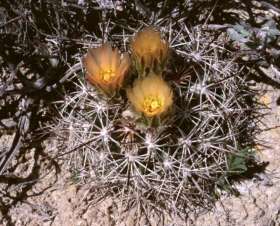
Pediocactus
sileri in habitat |
|
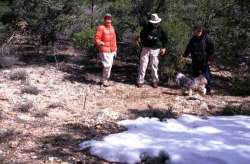
|
East of Jacob Lake we stopped
at another familiar spot where there is a large colony of Pediocactus
paradinei. This was my fourth visit to this spot this spring. The
first visit in late March found remnant snowbanks (left) still covering
many of the plants. By mid-April we found most of the plants on the
southerly exposures in full flower. A month later in late May, we found
many plants in shaded locations and on the northerly exposures still fully
flowered. P. paradinei is another federally protected Lilliputian
cactus of the Arizona Strip. |
| Above: A site
for Pediocactus paradinei in the Kaibab Forest seen in March with
snow still covering some plants.
Right; The usual yellow
blooms of paradinei and a rare peach coloured flowered form seen in
May at the same location.
(Click these thumbnails
for better images.) |
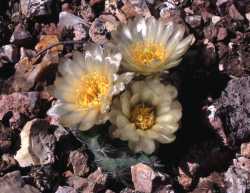
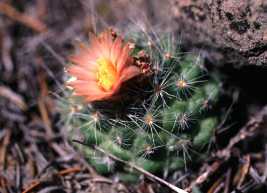
|
Further
east and a bit lower in elevation we stopped at another favourite cactus
spotting location. Here we were treated to a number of Escobaria vivipara
v. kaibabensis plants with their pointy petaled pink flowers. In
addition, we found the larger dark pink (purple) flowered Echinocereus
engelmannii along with many yuccas in flower.
Continuing
on to the Lees Ferry we decided to see if we might be lucky enough to find a few
flowers on the “many-headed barrel cactus,” Echinocactus polycephalus.
Unfortunately, and as expected, we were a bit too early to find flowers. Most of
these plants were well budded and should be blooming by mid June.
Ignoring
my tried & true technique for finding what I want to photograph, I was
carrying a camera on this short trek near the Colorado River. After a couple of
hundred yards, Carol decided she’d rather try to hide in the sparse shade of
salt cedar than walk about in the 100º F ± mid afternoon heat. I continued on,
inspecting every E. polycephalus along the way for flowers.
The
afternoon heat had apparently affected my brain because I’d completely
forgotten that my British friend, Trevor Wray, had previously told me about a
crested E. polycephalus he had found in this area. Carol & I had
tried, unsuccessfully, to find this plant on an earlier visit to the area.
|
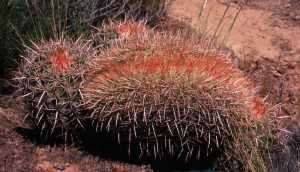
|
On
the verge of returning to the comfort of the air conditioned Pathfinder, but
spotting one more E. polycephalus to check for possible flowers, I
wandered a few feet off of the trail. The plant was flowerless, however, as I
turned to head back to the vehicle I spotted what appeared to be an extremely
large head on another many headed barrel cactus a few yards away and partially
obscured by a large rock.
|
Imagine
my very great delight when I got closer and realized I’d just found the
crested plant that had eluded Carol & I during our previous quest. This is a
very large plant with many individual heads, the largest being the magnificent
crested head. All of the normal heads were well budded and should be quite
impressive by mid June.
Question
to self: Is it worth a two day, 900 mile trip to possibly see and photograph
this incredible plant in flower sometime later in June???
As
mentioned, I had carried my camera and was able to capture this impressive plant
on film. Unfortunately, I’d left my GPS in the vehicle. The next visit I’ll
have to rely on my sometimes faulty memory if I’m ever to see this big beauty
again.
Shortly
after crossing the Navajo Bridge over the Colorado River, we began seeing many
bright pink spots along the roadside. Stopping at a wide spot, we walked a bit
and found a number of Escobaria vivipara and Echinocereus engelmannii
in flower. We also saw a few Opuntia whipplei plants with their
greenish-yellow flowers.
Early
evening found us returning to the Desert Rose Motel after dinner at the Twin
Rocks Cafe in greater downtown Bluff, UT. Walking from our vehicle to the room,
we were greeted by a distinguished sounding and looking gentleman who’d
noticed out “Cacti” license plate. He introduced himself as Richard Booth,
an extremely knowledgeable British cactophile from Wales who’s been visiting
the American southwest for many years. After a couple of hours of engrossing
cactus talk, I excused my self and headed off to bed... ending an extremely
satisfying day of cactusing!
Tuesday,
May 24
Leaving
Bluff we headed eastward, wandering around Hovenweep Nat’l Monument and McElmo
Canyon. Here we saw & photographed a number different prickly pear cacti in
flower. We also provided a free lunch to swarms of the local “cedar gnats.”
I’m not sure that the Four Corners variety of gnats is quite as virulent as
those at my home in the Grand Valley. My bites didn’t itch, ooze or scab over
like they normally do around here.
We
continued on through Cortez and the Ute Mountain Ute Reservation. We’ve
observed that the Ute Mountain Utes are quite friendly to those frequenting
their casino, however, locked gates and no trespassing signs are definite
impediments to cactophiles in search of the rare Sclerocactus mesae-verdae.
Crossing
into New Mexico and the Navajo Reservation we find that many of the side roads
are actually numbered, shown on maps, unposted and apparently available to the
discrete cactophile for a bit of cactus hunting.
| We
were unsuccessful in our search for the Mesa Verde Cactus on a likely looking
side road and proceeded to a spot where we’d found a couple of plants on a
previous visit. We were unable to refind the plants we’d seen earlier...
perhaps dead from drought, buried at the bottom of a cow track, or??? Carol did
spot several dead plants and finally a very few live ones, including three very
small seedlings. One three-headed plant had flowered and was maturing several
fruits. Unfortunately, we didn’t have time to look at other possible sites. |

|
Wednesday,
May 25
Going
north from Farmington, NM, we crossed back & forth between Colorado &
New Mexico a couple of times. We stopped at what we believe to be the one and
only secret site of Pediocactus knowltonii. The fact that these plants are early
bloomers combined with all of the “lush” cheat grass and other late spring
vegetation prevented us from finding these marble sized midgets in habitat.
Later
that day we visited a gravely knob where we’d previously had some success
finding interesting cacti. This turned out to be a very rewarding stop. We found
many of the little Fendler Hedgehogs (Echinocereus fendleri) in full
flower. On a previous visit we’d only found one E. fendleri, however,
the large dark pink (purple) flowers greatly facilitated the finding. Also
blooming were Sclerocactus cloverae which look similar to our local S.
parviflorus. Not flowering, but also on this gravely knob, were Opuntia
whipplei, Escobaria vivipara and prickly pears
Still
later we revisited another familiar cactus site where we enjoyed wandering
amongst a magnificent colony of giant spiny stars (Escobaria vivipara).
These are quite large mounds that seem to be getting bigger and more impressive
each time we visit. It’s incredible that these “giants” are not only
surviving but thriving since this area appears to be a heavily used wintering
ground for both deer and elk. We found some mounds well budded but only one
bright pink flower had appeared so far this season.
Thursday, May 26
After
indulging in some of the epicurean delights offered in Durango, we headed home
to the Grand Valley...via Farmington, Shiprock, Cortez, Hovenweap,
Disappointment Valley, Nucla, and Unaweep Canyon. Not exactly the most direct
route home, but who ever heard of a cactophile taking the direct route? Cactus
hunting was a bit disappointing on this leg of the trip. We saw a number of the
more common species, many in flower, but nothing unusual. The scenery and
weather, however, were outstanding, easily compensating for the sparsity of
exotic cacti.
A
great trip!
Don
Ed:
And did Don make that 900 mile trip to see Echinocactus polycephalus in
bloom? He emailed in mid-June, "Turns out I didn't need to bother...the
plants are apparently all bloomed out for this year. A very nice woman at
the Lees Ferry Lodge actually drove out to the vicinity of Badger Point after
she got off work to check on the flowering status of the plants... so something
to look forward to next May".
And
a picture to look forward to in a future issue of Northants News, please?







